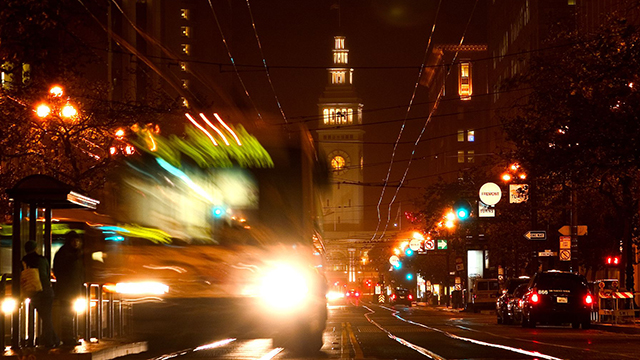At a hearing before the city's Land Use and Economic Development Committee earlier this month, some restaurant and bar owners said their employees, who often leave work in the early-morning hours with the cash tips they earned, don't feel safe waiting for late buses. Many live in the East Bay or South Bay because they can't afford San Francisco rent.
"Increasing late-night transportation is really a critical public safety issue for workers and for customers in San Francisco," said Tom Temprano of Virgil's Sea Room in the Mission.
John Haley, director of transit for the San Francisco Municipal Transportation Agency, admitted that Muni's Owl service is "uneven" and there is less of a focus on overnight on-time performance. That's because operators will sometimes wait for regular riders, or buses will get stalled waiting for connections with regional buses like AC Transit.
"We want to make sure that people have a way, and that we don't leave them stranded," Haley said.
Muni's Owl network currently serves 10 lines from 1 a.m. to 5 a.m. Buses are supposed to arrive every 30 minutes, but that can sometimes turn into 45 minutes or even an hour. Haley said the SFMTA is currently looking into increasing overnight bus service along the N-Owl and L-Owl lines by providing a shuttle between Embarcadero and West Portal. It's also considering more overnight bus service along Market Street, including extending the hours of the F-Line.
Operating light-rail service at night would be difficult, Haley said, because, like BART, Muni needs that down time to do maintenance. But at Wiener's request he agreed to prepare a report exploring the possibilities.
At the same hearing, a BART official repeated what the agency has stated many times over the years: It cannot do overnight service because it needs that critical window to do maintenance on an aging system.
"The system was never built for 24-hour service," said Jay Bolcik, BART's schedule and service planning manager. "Decisions made 50 years ago are the frustrating consequences that I have to deal with as a service planner in terms of trying to deliver the best possible service."
Bolcik said the overnight bus options that are available via AC Transit are "under-utilized." A survey of Polk Street patrons by the SFMTA one night last year confirmed that many were not aware of late night-transit options. Thirty-seven percent were unaware of Muni and transbay overnight service. Twenty percent said they were aware of it, but didn't know where the services ran. Transportation officials at the hearing agreed that transit agencies could do a better job getting the word out.
Riders looking to get back to the East Bay overnight have to rely on AC Transit's 800 bus. BART and AC Transit officials are considering an $800,000 pilot plan to add buses and increase service on Friday and Saturday nights, including extending the 800 line to the Mission District. The earliest that could happen is December. Riders looking to get to the Peninsula or South Bay have scarcer options, but SamTrans' 397 bus runs once an hour.
One challenge to boosting overnight service is funding, but Thea Selby of the San Francisco Transit Riders Union suggests an increase in late-night Muni service could come from raising the vehicle license fee.
"Better service doesn't grow on trees. Late-night transit needs to come from increased revenue, not decreased service," Selby said. "The vehicle license fee, which the Mayor's Transportation Task Force voted to support on the ballot this November, could partially go towards that service. That could be where the funds come from without losing service elsewhere."
Wiener said he hopes the working group will come up with some short- and mid-term recommendations that would be "low cost or even no cost," along with some more visionary goals.
"We've never studied late-night transportation in a meaningful way before," Wiener said. "When transit agencies look to the future, we want them to have that policy tool, a comprehensive plan with recommendations, that they can look to."
The group is expected to report to the Board of Supervisors on its progress in six months.
